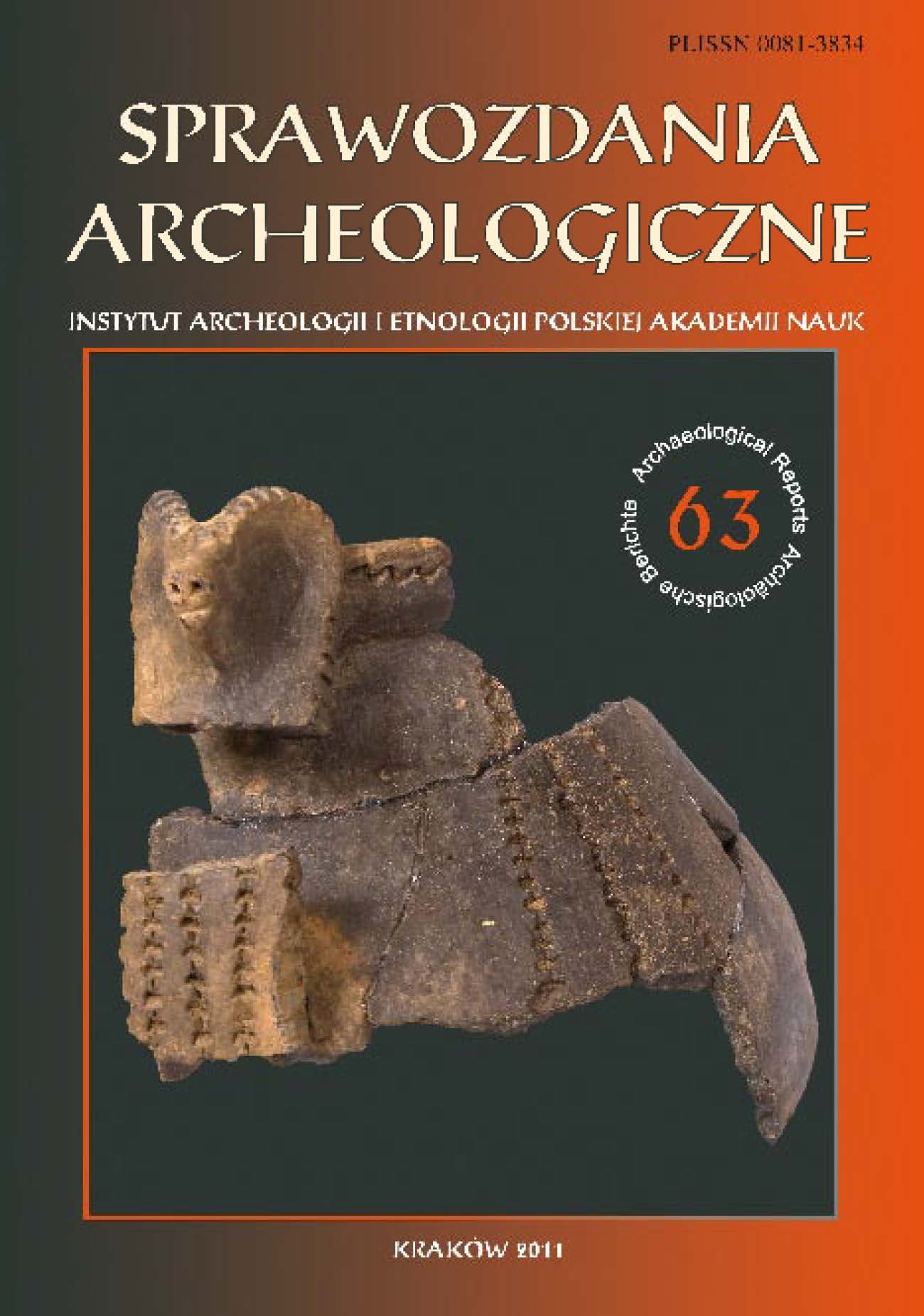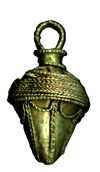Silos and Granery Pits within Medieval Europe. A Typological Study: the Case of Miranduolo (Siena, Italy)
Słowa kluczowe:
Middle Ages, Italy, Miranduolo, storage pits, granariesAbstrakt
The process of storing food has always been a critical social and economic problem and, as such, a truly relevant issue for material culture. In early medieval times the control of resources like food supplies represented, in Western Europe, a real marker of economic power. During dark ages, food supplies were stored inside different structures, related to single dwellings; such structures were totally under the control of local elites except for small storages representing nuclear supplies. In Slavic Eastern Europe these cases were not exceptions: each dwelling was typically associated with a storing structure, be it a granary pit or a silo. The aim of this work is to present different examples of pits within western and eastern European contexts. Seven typologies were identified in the European literature. The present catalogue is based upon forty-four settlements ranging between the 6th and the 12th century, with a more detailed analysis on the settlement of Miranduolo (Siena)
Pobrania
Bibliografia
Andrews D. 1982. Underground grain storage in central Italy in Medieval Lazio: studies in architecture, painting and ceramics. Papers in Italian Archaeology III (= British Archaeological Reports. International Series 125). Oxford, 123-130
Andronic M. 2005. Teritoriul Nord-Est Carpatic în a doua jumătate a primulu mileniu creştin. Suceava
Bakels C. C. 1999. Dury “Le Moulin”. Étude des restes botaniques. Revue archéologique de Picardie, Année 1999/1, 237-245
Baran V. D. 1988. Prazhskaia kul’tura podnestvov’ia (Po materialam poselenij u.s. Rashkov). Kiev
Bromberger P. Ch. 1979. Note sur la terminologie des reserves a cereals. In M. Gast and F. Sigaut (eds.), Les tecniques de conservation des grains ǎ long terme. Paris
Brzostowicz M. 2002. Bruszczewki zespół osadniczy we wczesnym średniowieczu. Poznań
Buko A. 2003. Wczesnośredniowieczna osada w Kaczycach koło Opatowa: zagadkowy epizod w dziejach osadnictwa wczesnośredniowiecznego na Wyżynie Sandomierskiej. Archeologia Polski 48, 2003, 113-156
Cantini F., Buonincontri S. and Serugeri S. 2009. Al centro della rete: archeologia di un central place della Toscana settentrionale tra V e XIII secolo. Il caso di vicus Wallari-borgo San Genesio. In Atti del V convegno della Società degli Archeologi Medievisti Italiani, (Palazzo della Dogana, Salone del Tribunale (Foggia), Palazzo dei Celestini, Auditorium (Manfredonia), 30 settembre - 3 ottobre). Firenze, 255-26
Carpentier V. and Dietsch Sellami M. F. 2007. Le site de Plomb “le Mesnil” (Manche), IX-XII siècle: Regard sur l’habitat rural du haut Moyen Âge dans l’Ouest français. Archéologie Médiévale 37. Paris, 12-15
Castillo J. A. Q. 2008. Informe de la primera campańa de excavación en el castillo de Trevińo, Grupo de Investigación en Arqueología Medieval y Postmedieval Área de Arqueología de la Universidad del País Vasco. http://www.arqueologiadelasaldeas.com/documentos/TRE.pdf (22.08.2011)
Corman I. 1998. Contribuţii la Istoria Spatiului Pruto-Nistrian în epoca evului mediu timpuriu (sec. V-VII d. Chr.) (= Biblioteca ştinţifică a editurii Cartdidact 28). Chisinâu
Cortonesi A. 1988. Il lavoro del contadino: uomini, tecniche, colture nella Tuscia tardomedievale, CLUEB. Bologna, 129-131
De Santis P. and Valente M. 2000. L’area della domus A (Saggio I. 1993-1997) in G. Volpe, Ordona X: Ricerche archeologiche a Herdonia (1993-1998). Bari, 50-57
Di Falco G. 2005. Il castello di Miranduolo: primi dati archeobotanici (unpublished MA Thesis at the University of Siena, Italy). Siena
Di Pasquale G., Di Falco G. and Moser D. 2008. Analisi archeobotaniche. In M. Valenti (ed.), Miranduolo in Alta Val di Merse (Chiusdino - SI). Archeologia su un sito di potere del Medioevo toscano, Firenze, 323-348
Donat P. 1980. Haus, Hof und Dorf in Mitteleuropa vom 7. Bis 12. Jahrhundert: Archäologische Beiträge zur Entwicklung und Struktur der bäuerlichen Siedlung in Schriften zur ur-und frühgeschichte. Berlin
Faure-Boucharlat E. (ed.) 2001. Vivre la champagne au Moyen Âge: l’habitat rural du Vè au XIIè s. (Bresse, Lyonnais, Dauphiné) d’après les données archéologiques, (= Document d’Archéologie en Rhône-Alpes et en Auvergne 21). Association Lyonnaise pour la Promotion de l’Archéologie en Rhône-Alpes: Lyon
Favia P., Annese C., De Stefano A., De Venuto G. and Di Zanni A. 2009. San Lorenzo “in Carminiano” presso Foggia: indagine archeologica su un sito medievale del tavoliere di Puglia in un contesto di moderna espansione edilizia. In V Congresso Nazionale di Archeologia Medievale. Foggia, 382-391
Favia P., Giuliani R. and Leone D. 2000. L’area delle terme (Saggio III. 1997-1998). In G. Volpe (ed.), Ordona X: Ricerche archeologiche a Herdonia (1993–1998). Edipuglia: Bari, 178-185
Favia P. and Pietropaolo L. 2000. L’area della domus B (Saggio I. 1993-1997). In G. Volpe (ed.), Ordona X: Ricerche archeologiche a Herdonia (1993-1998). Edipuglia: Bari, 102-105
Gabałówna L. and Nowakowski A. 1964. Wczenośredniowieczna osada na stanowisku 5 w Radziejowie. Prace i Materiały Muzeum Archeologicznego i Etnograficznego w Łodzi. Seria Archeologiczna, 239-251
Gabayet F., Gauthier F., Horry A., Rodet-Belarbi I. and Gaime S. 2005. Un établissement agricole du XIII siècle à Beaumont, Lieu-Dit la Mouraude (Puy-de-Dôme). Archéologie Médiévale 35, 115-117
Gągorowska J. 1998. Sprawozdanie z badań wczesnośredniowiecznej osady we wsi Pokrzywnica, woj. Kielce w latach 1993-1996. Sprawozdania Archeologiczne 50, 220-221
Gentili F. 2008. L’habitat du haut moyen âge de “la chapelle, la croix verte” au Mesnil-Aubry (Val d’Oise). Revue archéologique d’Île de France 1, 289
Gentili F. 2008. Villiers-le-Bel “la Confiserie”: habitat du haut Moyen Âge et village médiéval, Rapport final d’opération, février 2008. (unpublished typescript)
Gentili F. 2009. Silos et greniers. Structures de conservation des grains sur les sites ruraux du haut Moyen Âge d’après des exemples franciliens. In F. Gentili and A. Lefèvre (eds.), L’habitat rural du haut Moyen Âge en Île-de-France, 2° supplément au Bullettin archéologique du Vexin français et du Val-d’Oise (= Collectif d’archéologie rurale du haut Moyen Âge et Centre de recherches archéologiques du Vexin français). Guiry-en-Vexin, 96-122
Giaquinta R. 2010. Silos e fosse granarie, uno studio tipologico - il caso di Miranduolo (Si), Siena (unpublished Phd Thesis written at the University of Siena, Italy)
Guadagnin R. 1988. Catalogo della mostra. In Cuisenier J. and Guadagnin R. (eds.), Un village au temps de Charlemagne: moines et paysans de l’abbaye de Saint-Denis du VIIe siècle à l’An Mil: exposition Paris, Musée national des arts et traditions populaires, 1988-1989. RMN: Paris, 218-222
Guidoni E. De Minicis E. (ed.) 1996. Leopoli-Cencelle: una città di fondazione papale. Fratelli Palombi Editori: Roma
Gurba J. 1988. Wczesnośredniowieczna osada w Drzewcach-Kolonii, gm. Nałęczów (woj. Lublin). Sprawozdania Archeologiczne 39, 239-242
Harnay V. 1999. Dury “Le Moulin” (Somme), un village-rue du Moyen Âge (IXe au XIIe siècle). Revue archéologique de Picardie 1, 203-235
Hensel W. 1965. Słowiańszczyzna wczesnośredniowieczna: zarys kultury materialnej, wydanie trzecie uzupełnione. Państwowe Wydawnictwo Naukowe: Warszawa
Jacomet S. 2006. Pratical course: Identification of Archaeological Plant Remanins (macroremains: seeds, fruits, wood). IPAS. Basel University. http://ipna.unibas.ch/archbot/pdf/Cereal_Id_Manual_engl.pdf (22.08.2011)
Karg S. and Lafuente P. 2007. Food, Part 1: The South. In J. Graham-Campbell (ed.), The Archaeology of Medieval Europe. Aarhus University Press: Aarhus, 188-191
Kavánová B. and Vitula P. 1990: Břeclav-Poštorná, pohřebiště a sídliště střední doby hradištní. In Pravěké a slovanské osídlení Moravy. Sborník k 80.narozeninám Josefa Poulíka. Brno, 327-351
Koloba V. V. and Gorbachenko S. A. 2009. Zemierobstvo saltivskoj kulturi (za materialami Mokhna Chitws’kogo Gorodishcha. Vita Antiqua 7-8, 262-274
Kostrzewski J. 1962. Kultura Prapolska. Państwowe Wydawnictwo Naukowe: Warszawa
Kudrnáĉ J. 1958. Skladování obilí v jamách oblinicích in Vznik a Počátky slovanů. Praha
Kudrnáĉ J. 1970. Klučov: Staroslovanské hradište ve středních Čechách (= Monumenta Archaeologica 17). Praha
Kuna M. 2005. The settlement area at Roztoky in the context of the Prague-type culture: The features and structure of the residential area. In M. Kuna and N. Profantová, Počátky raného středověku v Čechách. Arvcheologicky ústav AV ČR: Praha, 319-354
Lapushkin J. J. 1958. Gorodishche Novotroitskoe. O kul’ture vostochnykh Slavian v period slozheniia kievskogo gosudarstva (= Materialy i issledovaniia po arkheologii SSSR 74). Izdatel’stvo Akademii Nauch SSSR: Moskva-Leningrad
Lityńska-Zając M. 2003. Materiały roślinne z wczesnośredniowiecznej osady w Kawczycach koło Opatowa. Aneks. Archeologia Polski 48, 157-164
Łojowska K. and Okoński J. 2008. Badania wykopaliskowe na stan. 1 i 5 w Ostrowie, pow. Przemyśl, w 2007 roku (Część Druga). Rocznik Przemyski. Archeologia 44(2), 53-69
Machnik J. 1961. Wyniki Badań w latach 1953-1954. Igołomia I. Osada wczesnośredniowieczna (=Prace Komisji Archeologicznej PAN O/Kraków 2). Wrocław, 11-112
Mariottini V. 2008. La ceramica acroma. In M. Valenti (ed.), Miranduolo in Alta Val di Merse (Chiusdino- SI). Archeologia su un sito di potere del Medioevo toscano, Firenze, 373-378
Musteǎţa S. 2005. Populaţia spaţiului pruto-nistrean în secolele VIII-IX. Chişnǎu
Nekuda V. 1973. Ranne stredoveke typy sidlistnich objektu ve Mstenicich. Casopis Moravského Musea v Brne. Vedy spolecenské 58, 77-96
Peytremann E. 2003. Archéologie de l’habitat rural dans le Nord de la France du IVe au XIIe siècle. Association Francaise d’Archeologie Merovingienne: Rouen
Peytremann E. and Frauciel M. 2006. L’habitat déserté de gungling à Grosbiliederstroff (Moselle) IX-début XVI siècle. In Archéologie Médiévale 36, CNRS Éditions: Paris, 70-71
Pignatti S. 1982. Flora d’Italia, Il Sole 24 ore: Bologna
Pleinerová I. 1975. Březno. Vesnice prvnìch Slovanů v severozápadnìch Čechách (= Památnìky našì minulosti 8). Praha
Pleinerová I. 2000. Die altslawischen Dörfer von Březno beim Louny. Praha - Louny
Profantová N. 1998. Doubravčice: K problematice počátků raně středověkého hradiště na základě výzkumů J. Kudrnáče. Archeologie ve Středních Čechách 2, 157-275
Saffiotti C. 2006. Il grano in fossa: una tecnica di conservazione alimentare a lungo termine. Siena (unpublished Phd Thesis written at the University of Siena, Italy)
Salvadori F. 2008. Analisi archeozoologiche. In M. Valenti (ed.), Miranduolo in Alta Val di Merse (Chiusdino - SI). Archeologia su un sito di potere del Medioevo toscano. Firenze, 348-370
Stanojev N. 1996. Mittelalterliche dörfliche Siedlungen vom 5. Bis zum 15. Jh. In der Wojwodina. Museum der Wojwodina: Novi Sad
Szydłowski J. and Wasylikowa K. 1973. Cereals from the Early Medieval Fortified Settlement in Lubomia, Discrict Wodzisław Śląski, Southern Poland. Folia Quaternaria 42. Kraków, 48-49, 73-76
Szmoniewski B. Sz. 2010. Materiały wczesnośredniowiecze i średniowieczne ze stanowiska 16 w Targowisku, gm. Kłaj, woj. Małopolskie. Kraków (unpublished typescript stored in Archiv of Krakowski Zespół do Badań Autostrad)
Valenti M. 2008. Lo scavo. In M. Valenti (ed.), Miranduolo in Alta Val di Merse (Chiusdino - SI). Archeologia su un sito di potere del Medioevo toscano. Firenze, 87-88, 104-107, 108-128
Valenti M. 2008. L’insediamento altomedievale (periodi VIII-VI). In M. Valenti (ed.), Miranduolo in Alta Val di Merse (Chiusdino - SI). Archeologia su un sito di potere del Medioevo toscano, Firenze, 84-164
Verhulst A. 2004. L’economia carolingia. Salerno, Roma
Vozniy I. 2009. Istorico-Kul’turnij Rozvitok Naselennia Mezhirichchia verkh’ogo siretu ta seredn’ogo Dnistra v X-IV st. In Material’na, Dukhovna Kul’tura ta Sotsial’no-Istorichnij Rozvitok. Kiiv-Chernivtsy, 61-63
Zohary D. and Hopf M. 2000. Domestication of plants in the old world. The origin and spread of cultivated plants in West Asia, Europe and the Nile Valley. New York
Zoll-Adamikowa H. and Szmoniewski B. Sz. 2007. Opis obiektów nieruchomych. In A. Buko (ed.), Stradów. Wczesnośredniowieczny zespół osadniczy 1 (= Polskie Badania Archeologiczne 36). Instytut Archeologii i Etnologii PAN: Kraków, 109-233
Pobrania
Opublikowane
Jak cytować
Numer
Dział
Licencja

Utwór dostępny jest na licencji Creative Commons Uznanie autorstwa – Użycie niekomercyjne – Bez utworów zależnych 4.0 Międzynarodowe.














